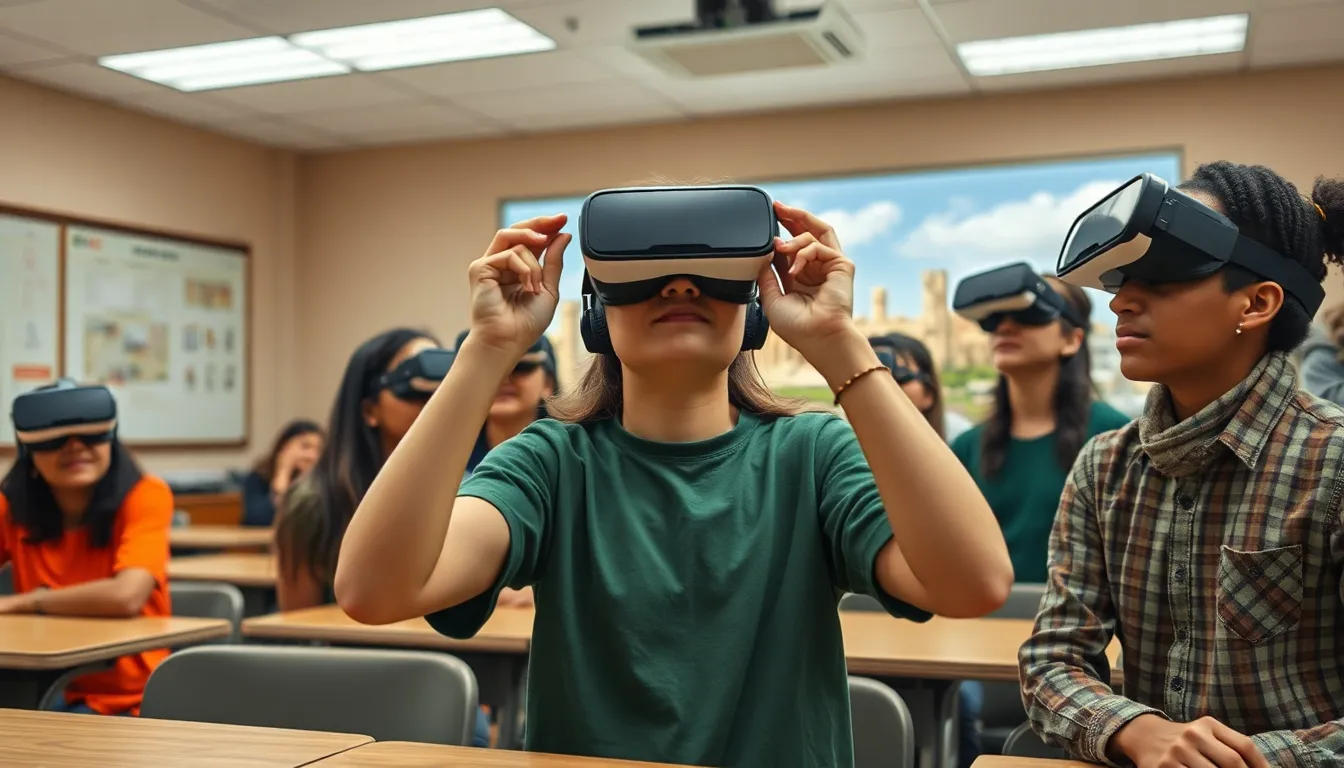Table of Contents
ToggleIn a world where textbooks can feel as exciting as watching paint dry, virtual tours for education swoop in like a superhero with a cape made of Wi-Fi. Imagine exploring ancient ruins, diving into the depths of the ocean, or wandering through art galleries—all from the comfort of your couch. These immersive experiences not only spark curiosity but also make learning feel like an adventure rather than a chore.
Overview of Virtual Tours for Education
Virtual tours transform educational experiences, offering students access to diverse environments without needing to travel. These immersive experiences enhance learning by providing real-world contexts that textbooks alone cannot convey. Students can virtually explore ancient ruins, marine ecosystems, and renowned art galleries, making the study of history, science, and art more engaging.
Platforms like Google Arts & Culture and Nearpod facilitate these virtual experiences, allowing educators to integrate interactive lessons into their curriculums. Numerous educational institutions leverage virtual tours to broaden student perspectives and deepen understanding of complex subjects. Participants benefit from firsthand views of historical sites, fostering a connection to the material that traditional resources often lack.
Accessibility plays a crucial role in the effectiveness of virtual tours. Students in remote or under-resourced areas can benefit from experiences that would otherwise be out of reach. Additionally, virtual tours are often more cost-effective than field trips, removing barriers related to travel and accommodation expenses.
Engagement rises significantly during virtual tours, with students more likely to retain information gathered during an interactive session. Research indicates that visual learning enhances memory retention. This interactive element creates a dynamic classroom environment that promotes curiosity and further exploration of subjects.
Curriculum integration is essential for maximizing the benefits of virtual tours. Educators can develop lesson plans that align with virtual components, ensuring that students gain relevant skills and knowledge. Diverse subjects such as geography, science, and literature can incorporate virtual exploration, enriching overall educational experiences.
Benefits of Virtual Tours

Virtual tours transform educational experiences, ensuring engagement and accessibility for students everywhere.
Enhanced Learning Experience
Immersive virtual tours create unique learning environments. Students explore ancient ruins, ocean depths, and art galleries without leaving home. Engagement increases as visuals stimulate interest, fostering deeper connections with complex subjects. Research shows that interactive learning enhances memory retention. Educators appreciate how these tours enrich lessons in geography, science, and literature. As they integrate virtual components, classrooms become vibrant spaces that encourage curiosity and exploration.
Accessibility and Inclusivity
Accessibility defines the power of virtual tours. Students from remote or under-resourced areas gain access to experiences previously beyond reach. These immersive tools eliminate barriers related to travel and accommodation expenses. Educational institutions increasingly prioritize inclusivity by using virtual tours, ensuring all students can participate in enriching experiences. Diverse environments become available, allowing everyone to engage with the material regardless of location. Thus, virtual tours democratize education, enhancing opportunities for all learners.
Popular Platforms for Virtual Tours
Virtual tours thrive on advanced platforms that enhance educational experiences. Below are notable examples that educators frequently utilize to captivate students.
Google Earth
Google Earth offers comprehensive views of geographical locations and landmarks. It immerses students in interactive explorations of the globe. Users can navigate through 3D environments, allowing them to understand spatial relationships directly. Students can witness contexts like city layouts or natural wonders firsthand, reinforcing geographical concepts. Features like Voyager provide curated stories and guided tours, enhancing the learning experience with engaging narratives. This platform integrates seamlessly into classroom settings, making it easier for educators to align lessons with global geography.
Facebook’s Immersive Technology
Facebook’s immersive technology enables users to interact within virtual environments through 360-degree photos and videos. Educators leverage this tool to transport students to historical sites or cultural festivals instantly. The platform allows for shared experiences, making remote learning collaborative and engaging. Rich media experiences support various subjects, including social studies and art, by providing firsthand exposure to diverse cultures and events. This accessibility fosters discussion and connection among students, cultivating a deeper appreciation of global diversity. As such, Facebook’s technology enhances traditional educational resources, enriching student engagement significantly.
Case Studies in Virtual Tours for Education
Virtual tours are making significant strides in educational settings, demonstrating their effectiveness through various successful implementations.
Successful Implementations
Several universities have incorporated virtual tours into their curricula. For instance, Stanford University utilizes virtual field trips to enhance environmental science studies, allowing students to explore ecosystems across the globe. Such immersive experiences enrich comprehension and offer real-world context. Concurrently, the University of Michigan employs virtual museum tours to facilitate art history classes, deepening students’ appreciation for diverse artworks. These implementations showcase the capability of virtual tours to provide hands-on learning experiences that were previously unattainable due to logistical or financial constraints.
Student Feedback and Engagement
Student feedback often highlights increased motivation and interest levels during virtual tours. Surveys from participants at educational institutions reveal that 90 percent of students report improved understanding of complex subjects through immersive experiences. Engaging with virtual environments stimulates curiosity and critical thinking. Active participation during virtual tours encourages students to ask questions, fostering collaborative discussions. Educators note that learners develop a stronger connection to the material, ultimately enhancing retention. Such positive responses indicate the significant impact virtual tours have on student engagement and learning outcomes.
Challenges and Limitations
Virtual tours create immersive learning environments, yet several challenges hinder their effectiveness in education. One significant limitation involves technology access. Many students lack reliable internet connections or devices, restricting participation in virtual tours.
Additionally, the lack of in-person interaction can diminish the learning experience. Physical presence in a classroom fosters collaboration and communication that virtual settings often cannot replicate. Students might struggle to engage with content fully without face-to-face contact.
Quality of content presents another challenge. Not all virtual tours offer accurate or comprehensive information, leading to the potential for misinformation. Educators must vet tours thoroughly, ensuring they align with curriculum standards.
Time constraints also impact the integration of virtual tours. Teachers face tight schedules, making it difficult to allocate time for these segments. Virtual tours must fit seamlessly into existing lesson plans, which isn’t always feasible.
Furthermore, educators may lack sufficient training to utilize these tools effectively. Without professional development, teachers might not maximize the educational potential that virtual tours offer.
Finally, student motivation can fluctuate during virtual experiences. While some students thrive in engaging formats, others may lose interest without traditional, hands-on activities. Overall, while virtual tours enhance learning opportunities, recognizing and addressing these limitations remains vital for implementation in educational settings.
Future of Virtual Tours in Education
Emerging trends show that virtual tours will become integral to education. Technological advancements increase access to high-quality immersive experiences, enabling more students to explore remote locations and cultural landmarks from their classrooms. Innovations in virtual reality are set to enhance engagement further, allowing learners to interact with environments and subjects dynamically.
Platforms that specialize in virtual tours are expanding their offerings, which broadens possibilities for educators. Google Arts & Culture and Oculus are continuously updating their features to provide richer experiences, ensuring that immersive education remains relevant and engaging. With improvements in accessibility, even students in remote or underserved areas can participate in these innovative learning opportunities.
Integration into curriculums strengthens the educational impact of virtual tours. Educators can align tours with lesson plans, thus enhancing subject comprehension. Research indicates that aligning virtual experiences with traditional teaching increases retention rates significantly, with studies noting that 93 percent of participants appreciate lessons that incorporate interactive elements.
Networking among educational institutions promotes collaboration in developing virtual tour content. Sharing best practices and resources creates a collective knowledge base, enabling institutions to harness virtual tours more effectively. Collaboration fosters innovation, which paves the way for new educational methodologies.
Addressing challenges will be crucial for maximizing future potential. Limited technology access still exists, and investment in infrastructure is needed to even the playing field. Training for educators remains essential so they can effectively utilize these tools and inspire students. As this field evolves, prioritizing inclusivity and equitable access will enhance the educational landscape for all learners.
Virtual tours are reshaping the educational landscape by providing unique and immersive experiences that engage students in ways traditional methods often can’t. They break down geographical barriers and offer access to diverse environments, enriching learning opportunities for all students.
As technology continues to evolve, the potential for virtual tours in education will only expand. By integrating these experiences into curriculums and prioritizing inclusivity, educators can enhance student engagement and understanding.
The future of education is bright with virtual tours at the forefront, fostering curiosity and deeper connections to complex subjects. Embracing this innovative approach will ensure that all learners benefit from a richer and more dynamic educational experience.





